Categories: Featured Articles » Interesting Facts
Number of views: 39972
Comments on the article: 4
Wireless power transmission methods
 The law of the interaction of electric currents, discovered by Andre Marie Ampere in 1820, laid the foundation for the further development of the science of electricity and magnetism. After 11 years, Michael Faraday experimentally established that a changing magnetic field generated by an electric current is capable of inducing an electric current in another conductor. So it was created first electric transformer.
The law of the interaction of electric currents, discovered by Andre Marie Ampere in 1820, laid the foundation for the further development of the science of electricity and magnetism. After 11 years, Michael Faraday experimentally established that a changing magnetic field generated by an electric current is capable of inducing an electric current in another conductor. So it was created first electric transformer.
In 1864, James Clerk Maxwell finally systematized the experimental data of Faraday, giving them the form of exact mathematical equations, thanks to which the basis of classical electrodynamics was created, because these equations described the relationship of the electromagnetic field with electric currents and charges, and the consequence of this should be the existence of electromagnetic waves.
In 1888, Heinrich Hertz experimentally confirmed the existence of electromagnetic waves predicted by Maxwell. His spark transmitter with a chopper based on a Rumkorff coil could produce electromagnetic waves with a frequency of up to 0.5 gigahertz, which could be received by several receivers tuned in resonance with the transmitter.
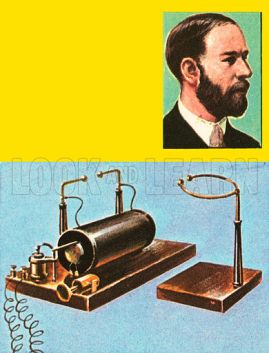
The receivers could be located at a distance of up to 3 meters, and when a spark occurred in the transmitter, sparks also appeared in the receivers. So were held first experiments on wireless transmission of electrical energy using electromagnetic waves.
In 1891 Nikola Tesla, while studying alternating currents of high voltage and high frequency, he comes to the conclusion that it is extremely important to select both the wavelength and the operating voltage of the transmitter for specific purposes, and it is not necessary to make the frequency too high.
The scientist notes that the lower limit of frequencies and voltages at which at that time he was able to achieve the best results is from 15,000 to 20,000 fluctuations per second with a potential of 20,000 volts. Tesla received a high-frequency and high-voltage current using an oscillatory discharge of a capacitor (see - Tesla Transformer) He noted that this type of electric transmitter is suitable for both the production of light and the transmission of electricity for the production of light.
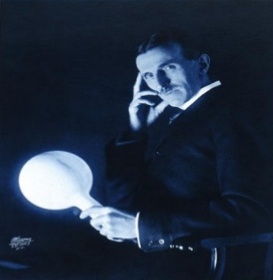
In the period from 1891 to 1894, the scientist repeatedly demonstrates the wireless transmission and glow of vacuum tubes in a high-frequency electrostatic field, while noting that the energy of the electrostatic field is absorbed by the lamp, converted into light, and the electromagnetic field energy used for electromagnetic induction in order to obtain a similar The result is mainly reflected, and only a small fraction of it is converted into light.
Even using resonance in transmission using an electromagnetic wave, a significant amount of electrical energy cannot be transmitted, the scientist claimed. His goal during this period of work was to transfer precisely a large amount of electrical energy wirelessly.
Until 1897, in parallel with the work of Tesla, research on electromagnetic waves was carried out by: Jagdish Boche in India, Alexander Popov in Russia, and Guglielmo Marconi in Italy.
Following Tesla’s public lectures, Jagdish Bose speaks in November 1894 in Calcutta with a demonstration of wireless transmission of electricity, where he ignites gunpowder, transmitting electric energy to a distance.
After Boche, namely on April 25, 1895, Alexander Popov, using Morse code, broadcast the first radio message, and this date (May 7 in a new style) is now annually celebrated in Russia as Radio Day.
In 1896, Marconi, arriving in the UK, showed off his apparatus by transmitting a signal 1.5 kilometers from the roof of the post office building in London to another building using Morse code.After that, he improved his invention and managed to transmit a signal along the Salisbury Plain already at a distance of 3 kilometers.
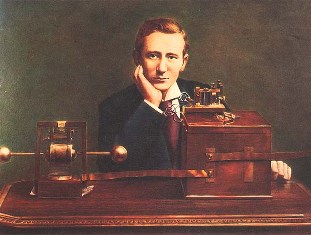
Tesla in 1896 successfully transmits and receives signals at a distance between the transmitter and receiver of about 48 kilometers. However, so far none of the researchers have succeeded in transmitting a significant amount of electric energy to a large distance.
Experimenting in Colorado Springs, in 1899, Tesla writes: "The failure of the induction method seems huge compared to the method of exciting the charge of earth and air." This will be the beginning of a scientist’s research aimed at transmitting electricity over considerable distances without using wires. In January 1900, Tesla will make a note in his diary about the successful transfer of energy to the coil, "carried far away into the field" from which the lamp was powered.
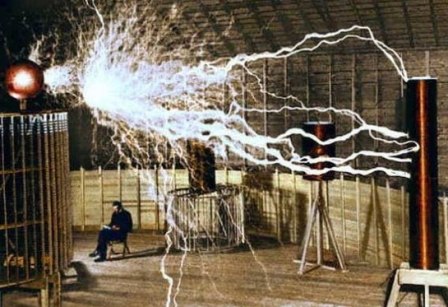
And the scientist’s most grandiose success will be the launch on June 15, 1903 of the Vordencliff tower on Long Island, designed to transmit electric energy over a considerable distance in large quantities without wires. The grounded secondary winding of the resonant transformer, topped by a copper spherical dome, was supposed to excite a charge of earth and conductive layers of air in order to become an element of a large resonant circuit.

So the scientist managed to power 200 lamps of 50 watts at a distance of about 40 kilometers from the transmitter. However, on the basis of economic feasibility, the financing of the project was stopped by Morgan, who from the very beginning invested money in the project with the goal of receiving wireless communications, and transferring free energy on an industrial scale to the distance as a businessman categorically did not suit him. In 1917, the tower, designed for wireless transmission of electrical energy, was destroyed.
Read more about the experiments of Nikola Tesla here:Resonant method of wireless transmission of electric energy by Nikola Tesla
Much later, in the period from 1961 to 1964, an expert in the field of microwave electronics, William Brown, experimented in the United States with microwave energy transmission paths.
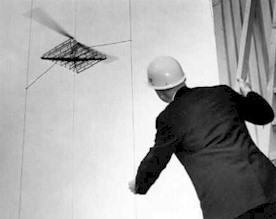
In 1964, he first tested a device (helicopter model) capable of receiving and using microwave energy in the form of direct current, thanks to an antenna array consisting of half-wave dipoles, each of which is loaded with highly efficient Schottky diodes. By 1976, William Brown had transferred microwave power of 30 kW to a distance of 1.6 km with an efficiency exceeding 80%.
In 2007, a research team at the Massachusetts Institute of Technology under the direction of Professor Marina Solyachich was able to wirelessly transmit energy to a distance of 2 meters. The transmitted power was enough to power a 60 watt bulb.
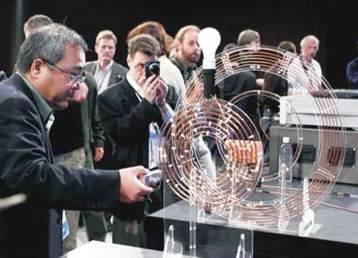
At the heart of their technology (called WiTricity) lies the phenomenon of electromagnetic resonance. The transmitter and receiver are two copper coils 60 cm in diameter resonating at the same frequency. The transmitter is connected to an energy source, and the receiver is connected to an incandescent lamp. The circuits are tuned to a frequency of 10 MHz. The receiver in this case receives only 40-45% of the transmitted electricity.
Around the same time, Intel demonstrated a similar technology for wireless power transmission.

In 2010, the Haier Group, a Chinese manufacturer of household appliances, presented at CES 2010 its unique product - a fully wireless LCD TV based on this technology.
Read also on this topic:Qi Electronic Power Wireless Standard
See also at bgv.electricianexp.com
:
